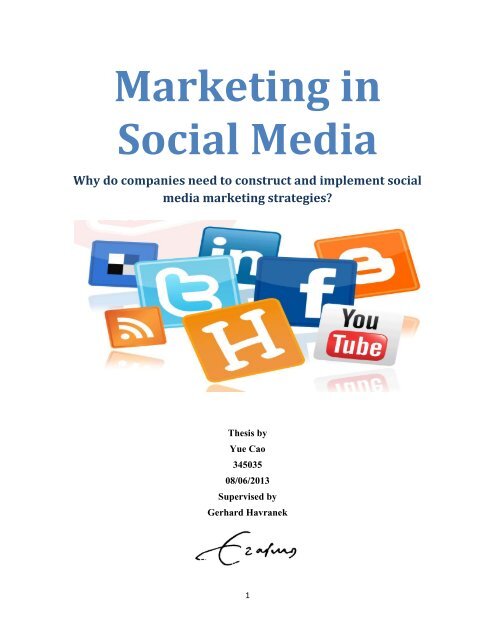Marketing In Social Media - EUR Thesis Repository
Marketing In Social Media - EUR Thesis Repository
Marketing In Social Media - EUR Thesis Repository
You also want an ePaper? Increase the reach of your titles
YUMPU automatically turns print PDFs into web optimized ePapers that Google loves.
Chapter 1 <strong>In</strong>troductionIt is predicted by many marketing managers that it will soon be the year when socialmedia are integrated in the organizations and effectively start to become useful forcompanies and become important tools in the communication. It is true that with the ITtechnology has been developing year after year, the development of marketing strategyis connected with <strong>In</strong>ternet, especially social media. David Aaker, a well-knownmarketing expert, has said that with the multitude of new developing, it is becomingincreasingly difficult for companies to raise awareness for their brand. The only wayforward in managing this complexity, is for companies to be able to coordinatemessages and their marketing efforts across all media (Aaker, 1996). It is accurate whatAaker has predicted for the complexity of increasing brand awareness through media inthe future.1.1 Problem definitionWith the widely using of online marketing, the effect of social media marketing shoulddefinitely be considered as a factor which matters in a company’s marketing mix. Onereason for the growing of social media marketing is that traditional advertising is losinginfluence on consumers. If it is the case, marketing promotions and activities whichbased on these social media platforms seem to be very important for a company. So itcould be an interesting topic to research how social media marketing affect companies.<strong>In</strong> other words, how could a company correctly construct and implement social mediastrategies. Besides, the marketing competition among firms through social mediaplatforms is becoming more and fiercer. Thus, the optimal approach for a company toconstruct and implement their marketing strategies in social media should be studied.According to the problem definition, a research question is introduced as following.4
Chapter 2 <strong>Social</strong> media marketing-Notions &Concepts2.1 Web 2.0The term Web 2.0 was introduced in 1999 which demonstrates web sites that usetechnology beyond the static pages of earlier web sites. Generally, a Web 2.0 site allowsinternet users to interact and collaborate with others based on a social media dialogue.These users are described as creators of user generated content. Technically, examplesof Web 2.0 include social networking sites (Facebook), blogs, wikis (Wikipedia), andvideo sharing sites (Youtube).From the perspective of marketers, it is apparent that Web2.0 offers an opportunity toengage consumers. The number of marketers who are using Web 2.0 tools tocollaborate with consumers on product development, service enhancement andpromotion are increasing (Parise, Salvatore, 2008). By using the Web 2.0, smallbusinesses have become more competitive to compete with larger companies. Forinstance, a company could offer customers coupons and discounts for products andservice directly via social networking sites which is more intuitive and user friendly.(SanFrancisco Chronicle, 2010) Under this circumstance, social networking sites havebecome marketing tools naturally and once a company succeeds, potential profits willbe generated automatically.2.2 <strong>Social</strong> <strong>Media</strong>According to Evans (2008), social media relates to a self-generated, authenticconversation between people about a particular of mutual interest, built on thethoughts and experiences of the participants. Therefore, social media is definitely all6
about sharing and aiming at a collective version, often intending to offer a moreappropriatedor informed choice at the end. Furthermore, social media changes overtime as it allows people to generate the content in a participative way whenever theywant to add any additional piece of information.<strong>Social</strong> media consists of online and mobile, word-of –mouth forums which includingsocial networking websites, blogs, company sponsored discussion boards and chatrooms, consumer-to-consumer email, consumer product or service ratings websites,<strong>In</strong>ternet discussion boards. These social media is growing gradually in recent years.Figure above shows the average hours per week people spent on online activitiesworldwide. It is clear that people spend most of their online time on social activities. <strong>In</strong>other words, they spend many hours on social networking websites. The implication ofthis trend is apparent. <strong>Marketing</strong> activities should be implemented on these platformsin order to attract the mass audience who spend their time more on the <strong>In</strong>ternet thantraditional media2.3 <strong>Social</strong> media and marketingHow to define social media marketing? It is different from traditional marketingperspective to some extent. <strong>Social</strong> media marketing focus on people and individualrather than products. One reason is that products can be presented by the company7
with many qualitative features and promotional tools, the thing matters most are thecomments and appreciations dropped by the customers.This is also why social media marketing is gradually changing the marketing in traditionalmedia. Because marketers are not able to control the contents anymore if these contentare generated by <strong>In</strong>ternet users. Negative information about your product or companymay be spread universal only within a few minutes. The famous case “United BreaksGuitar” can be a good example to explain this. Therefore, it could be concluded thatbased on the expansion of <strong>In</strong>ternet users and the development of social media, socialmedia has become a factor which influences the consumer behaviors to some extent.As a consequence, the competence and ability to influence the crowd is becomingrather important for marketing management. The optimal situation in social mediamarketing is to build a strongly connected relationship between customers andcompanies. <strong>In</strong> this case, companies are able to listen, track to the feedback fromcustomers timely and then make improvements of the products or services.2.4 User-Generated ContentUser-generated content (UGC) is published information that <strong>In</strong>ternet users has providedto a web sites. The information could be in various forms, photos, blogs, comments,posts are all UGC. Nowadays UGC is mostly generated on the social networking websites.One feature of UGC is that the contributors are normally unpaid, which means they arenot those experts who are paid in order to promote some certain products or service onthe <strong>In</strong>ternet. UGC allows <strong>In</strong>ternet users to communicate with each other convenientlyand effectively based on interactive media. Besides, UGC is another form of creation forthe website content.From the perspective of a company, monitoring UGC from its own social media becomesincreasingly important. On the one hand, companies need to find out what is themarketing implication of customers’ feedback. On the other hand, monitoring UGCoffers companies more useful information which originally comes from customers.8
Chapter 3 Methodology and TheoreticalframeworkResearch methods are used to determine, discover, interpret, and formulate facts. Themain sources of information that used in this thesis were issued from <strong>In</strong>ternet articlesand online blogs on social media marketing, the purpose is to read up-to-datedinformation as the thesis is dealing with a new and trendy topic in marketing. Moreover,there are sufficient scientific articles which focuses on social media marketing are alsostudied in order to provide a stable theoretical argumentation.3.1 The research purposeIt is known to all that there are three categories of research purpose which areexploratory research, descriptive research and causal study. These three types ofresearches should be applied appropriately according to the content and material thatwill covered in the study. Thus, the exploratory research method which is also the mostsuitable method in this study is selected. The major emphasis of exploratory is on thediscovery of ideas and insights (Saunders et al. 2009). <strong>Social</strong> media marketing is a fairlynew topic in marketing field which there are no substantial researches have been made.3.2 The research approachThere are two main research approaches which are qualitative and quantitative.According to Greg (2007), depending upon the desired outcome for the research, socialscientists may choose between quantitative or qualitative designs. Since they seek toexplain events from different perspectives, both are valid ways to evaluate aphenomenon in the proper context.<strong>In</strong> this research of social media marketing, the qualitative is used because unlikequantitative research, there will be no statistical data or calculations aimed toestablishing correlations between certain variables. This is also determined by the9
esearch purpose and problem. Some qualitative techniques such as observations,analysis of texts and documents are used in this research. Under this circumstance, thequalitative approach is suitable for interpreting the arguments why social mediamarketing is crucial and how to develop a successful social media marketing strategythereupon. It is confident to say that these techniques will provide a great validity andreliability when dealing with the research question.3.3 The theoretical frameworkTwo relevant theoretical models can be seen as the foundations of social mediamarketing and will also be applied as the theoretical framework of this research.The first theory is the Brand Identity Planning model (Appendix 1) which is developed byDavid Aaker (2010). He discussed a way for companies to create a strong and durableproduct brand in an optimal situation. <strong>In</strong> his theory, the differentiation among threeconcepts (Brand Image, Brand Identity, and Brand Position) is offered. Moreover, themodel provides four viewpoints of a brand which are brand-as-product, brand-asorganization,brand-as-person, and brand-as-symbol. When a company decides to buildtheir brand identity, these perspectives should be taken into account. <strong>In</strong> some cases, acompany that only builds their brand identity with one perspective is not a problembecause the other three are useless or redundant for the company.The second theory that provides the research a strong theoretical background is the<strong>Social</strong> Network Analysis. The social network analysis comes from network theory whichunder the background that many mathematical and statistics studies have been done inthe sociology to examine the relation between social entities. According to the socialnetwork theory, the definition of social network is a set of actors that may haverelationships with one another (Hannemann, 2005). The perspective of this is individualactors in a community as nodes, the communications between these actors areconsidered to be ties, edges, links and connections (Appendix 2 provides an image ofsocial network after visualization). As people are supposed to be social animals, one’saction and decision might affect others (friends, colleagues, acquaintances, etc).10
Therefore, social network plays important role in the social media marketing as one’scomment for a certain product in the social media may influence other’s considerationof this product. This is very influential because the spread speed is significantly fasterthan ever.Chapter 4 SWOT Analysis<strong>In</strong> this chapter, the SWOT analysis of social media marketing is demonstrated.Strengths: The first strength is the large market to reach. The total number of facebookusers has been increasing year after year. According to its official website, Facebook hasalready reached 1.11 billion users (Facebook, 2013) which is an enormous number thatinflects the immeasurable influence of social media. Practically, this platform offers agreat power to a company to make marketing campaign as well as promotions.The second strength of social media could be attributed to its direct contact withaudience. It is different from traditional media marketing that the feedbacks are hard toobtain. For instance, SONY’s new product PlayStation 4 will be introduced at the end ofthis year. The company could gather useful information from its royal customers inorder to improve the product in both before and after its launch. The direct contact withaudience provides a company convenience in social media.Weaknesses: Apparently the social media are not perfect which means there areweaknesses exist. The first weakness is the difficulty of controlling. Because the socialmedia emphasis the role of users which means sometimes they have more poweragainst a company. For example, an unsatisfied product will be spread rapidly withnegative comments on the social media. These messages will harm a brand’s identityand even more important is that companies almost cannot control it.The second weakness is the lack of short term ROI. Heidi Cohen indicated in her article(2013) that social media does not drive ROI. Her argument is that social media only11
improved the customer engagement but not significant or necessary effect on ROI. Thisdrawback will emerge with the growth of using social media in business.Opportunities: The first opportunity is that more and more promotions andadvertisements are offered through social media. This provides the chance to socialmedia to become more effective advertising media. (Marinal Todi, 2008) Because it is anew platform that not all advertisers have fully involved the media to reach morecustomers. Appendix 3 shows the proportion between advertisement and consumers’time spent by media in the US, 2011. It can be concluded from this graph that thepercentage of time spent by consumers online surpasses the advertising spent on onlinemedia. It offers an opportunity to marketers to use social media aggressively whileimplementing their marketing activities.Apart from the potential advertising medium it could be, another opportunity of socialmedia is the possibility to reach certain groups that traditional media cannot achieve.Due to the extensive audience that social media has, accompanied with social networktheory to support. It allows more people to make connected with other people whoshare a common interest which is beneficial in not only building new relationships butalso valuable feedbacks to certain products or services more intelligent.Threats: Although social media are no doubt favorable for develop marketing activities,external threats might affect social media to some extent. The biggest threat is the lackof social media policy. Companies are worried about their employees because theycould deliver negative messages on social media and these messages can be seriouslydamaging the company’s reputation. <strong>In</strong> other words, there are not sufficient socialmedia policies to protect companies both legally and financially from their employees.Another threat comes from competitors. For instance, Google has been acquiring, onaverage, more than one company per week since 2010 (Rusli, 2011). These mergers andacquisitions done by big players may disappoint some loyal users.12
It is noteworthy that privacy may also become a threat. Recently more and more socialnetwork users are concerned their privacy in these social networking media. A study hasbeen done to analyze 540 Facebook profiles of student from Carnegie Mellon University.The result was surprising that 89% of these users gave their genuine names and 61%gave their pictures which are easy to identify. Most of them did not use the privacysetting on Facebook which results numerous unknown users could access their personalinformation. (Gross, 2005)Chapter 5 Theoretical & Empirical DataAnalysisTheoretical analysis<strong>In</strong> this theoretical analysis part, theories which are fundamental to construct socialmedia marketing strategy will be introduced and elaborated.5.1 Brand awarenessA great benefit by using social media in business is the increasing brand exposure.Normally, brand exposure occurs when customers are gaining more and moreawareness of a product or service. Because of the social media platforms, new brandsare able to establish themselves as well as spreading brand awareness. On the otherhand, social media platforms are not only for newcomers in business, but also will bebeneficial for existing brands. These existing companies implement their social mediamarketing activities throughout social media platforms in order to maintain and13
enhance their brand awareness. According to Stelzner (2012), he induced nine benefitsfor marketing in social media. It can be seen from the appendix 4 that increasedexposure is the major benefit for doing so.As a matter of fact, more and more companies are willing to establish their profiles onsocial media platforms which provide them opportunities to implement marketingstrategy. Additionally, a company’s social media platform offers the possibility topresent and promote its products and services in a more interactive way. Customerscould choose from their own interests instead of passive adoption.Mostly, social media marketing expand brand awareness by extending the onlinepresence of products and services (Red Bridge <strong>Marketing</strong> 2008). With the widelyapplication of social media in marketing, measurements of the impact of social mediamarketing on brand awareness becomes crucial. <strong>In</strong> fact, it could be measured by usingsocial media metrics which will be explained in detail in the empirical data analysis.According to the theory we learned from social media marketing, there are three majorfactors should be taken into account when measuring whether it is a successful socialmedia marketing strategy. 1) Measuring social media exposure 2) Measuring influence 3)Measuring engagement. These measurements are important for the customerrelationship. <strong>In</strong> this case, constructing an optimal social media strategy to enhance thebrand’s online awareness becomes fairly necessary.5.12 Targeted trafficAs mentioned before that the users of social media are growing exponentially, Facebookeven has reached users over 1 billion. Thus, social media become convenient platformsfor companies which are trying to market products or services online. One good socialmedia sites could drive visitors back to the company’s website which proved to be veryuseful tool in generating online traffic for the company.. <strong>In</strong> fact, before social media arises, people rely on information on traditional media.Traditional media satisfied people’s purpose of obtaining information, but they are14
limited in scope. That is why social media have become popular as a very broad scope.<strong>In</strong> social media, marketing campaigns can be implemented in an extensive medium baseon the demographics of the audience.How should the word “traffic” be defined in social media marketing? Simply saying iswhenever a user visits a website, it is traffic. However, only by increasing the traffic ofcompanies’ websites is not sufficient because of the blindness. What should be takeninto account initially is the “targeted traffic”, means the audience are indeed interestedin purchasing your products and then they visit the company’s website.It could be described that one of the biggest advantages of marketing in social media isthe ability to specify target groups. Generally, social media users are required to providetheir personal profiles in order to register (age, gender, geographical location,profession, etc.). These users’ data are stored in social media sites. Apparently, thesedata are useful for company’s marketing activity. As a consequence, these data can beused to specify the target groups. Hence, marketing messages could be delivereddirectly to a specific group of people who are the potential customers.5.13 <strong>Social</strong> media monitoringUnder the revolutionary technical progress, the way that market research has beentransformed more or less. The transparency of <strong>In</strong>ternet not only offers a company thepossibility to manage its social media marketing channels, but also allows the companyto gather competitors’ information or data more convenient.<strong>Social</strong> media channels offer the opportunity to spy on completion. Any company caneasily realize how everything is going on competitor’s website, corporate blogs, andsocial media pages (Facebook, Twitter, and Google+)Appendix 5 shows the necessity of social media monitoring in business nowadays. Anybusiness could be divided into five links which are R&D, production, marketing, salesand service. For each link in the production, monitoring social media plays a distinct role.During the periods of the marketing and sales, there are three functions to monitor15
social media. The first one is to identify brand strengths and bottlenecks acrossconsumer’s decision journey. The second function is to measure impact of earned mediain overall marketing mix. The third one is to identify influencers and engage them. Forexample, if a company wants to identify its brand strengths and shortcomings, it couldbe done by monitoring social media. Specifically speaking, the way to do this is toquantify User-Generated Content. The difficulty of quantifying UGC could be concludedinto the extremely large amount of data and the unstructured. <strong>In</strong> order to achieve thegoal, various practical approaches are introduced.Text mining: It is the process of extracting useful, meaningful, and nontrivialinformation from unstructured text in order to gain the useful marketing insights.Co-occurrence: It means that how many times a term is mentioned with another term.For instance, Apple often will be mentioned with its competitor Samsung. Then, a “liftratio” will be calculated by using a formula: lift (A, B) = P (A, B) /P (A) x P (B). P (A, B)represents the probability that both A and B appear in a given message. P (A) representsthe probability that term A appears in a given message. If lift ratio is less than 1, twoterms appear together less than 1 would expect by mere occurrence of each of the twoterms separately.Nielsen Buzz Metrics: It is a brand monitoring and analytics dashboard. The basicfunctions are listed as follows 1) Listen to what customers say 2) Identify key metricsand establish benchmark 3)Focus on key customer segments 4)Evaluate theeffectiveness of a marketing campaign.These are some examples of practical approaches which are related to social mediamonitoring. These metrics will help the company getting a better understanding of whatwill reach the target audience more effectively. To sum up, social media monitoringoffers plentiful opportunities in marketing.Empirical data analysis16
<strong>In</strong> this section, empirical data will be elaborated in order to answer the researchquestion. <strong>In</strong> order to make the analysis more practical as well as clearer, NIKE companyis selected to combine with the social media metrics. NIKE is one of the companies thathave fully embraced the power of social media as a way of enhancing its business and itsrelationship with its stakeholders (Shaw, 2012). By analyzing NIKE’s social mediapresence and engagement, we expect to answer the research question in a completeand precise way.5.21 Firm overviewNike is an American multinational corporation that is engaged in the design,development and worldwide marketing and selling of footwear, apparel, equipment andservices (Mashable). It is one of the world’s largest suppliers of athletic shoes andapparel (Sage, 2008) and a major manufacturer of sports equipment.NIKE is also a successful company in building their marketing activities on social mediaplatforms. It is because NIKE knows its biggest advantage is the positive communicationwith consumers which brings the company not only reputational benefit but alsopositive effect on sales.NIKE targeted on both male and female customers generally from the ages 15 to 35.These people are active and who enjoy high quality sporting goods. Through thesuccessful marketing in sports filed, NIKE has become a symbol for sports and youth.These good performances conducted by NIKE are expected to offer the research withconfident results on how to construct an appropriate social media marketing strategy.5.22 Overview of social media presence and engagementFacebookFigure 1 shows the NIKE’s Facebook page. The number of users who have clicked “Like”button is almost 14 million. <strong>In</strong> this page, NIKE posts their advertisements andpromotions. Facebook is useful in finding new customers, establishing online17
communications of fans. Moreover, by collecting users’ demographic information, NIKEis able to focus on the right target groups.When it comes to Business-to-Customers companies like NIKE, Facebook has become anextremely important social media channel in customer acquiring. Figure 2 shows theimpressive effect that Facebook has in terms of customer acquiring.TwitterTwitter also plays a crucial role in social media marketing. Figure 3 shows the NIKE’sTwitter profile. The number of followers is 1.45 million. It is a fact that nowadays Twitterhas become the dominator in social media channel because of its unique characteristicsand benefits. Generally, companies use Twitter as a news broadcasting, customerservice and information tool.Sharing information quickly is Twitter’s initial advantage in business. Company is able toincrease brand exposure as well as brand awareness by Twitter users’ share. Overall,there are three reasons for company to use Twitter in terms of marketing: 1) Developand promote a brand. 2) <strong>In</strong>teract with the target customers. 3) Monitor the feedback ofits products from customers.Linked<strong>In</strong>The main purpose of Linked<strong>In</strong> is to provide the opportunity for users to build andmaintain relationships. As for company, it is shown in the figure 4 which is the NIKE’scompany page in Linked<strong>In</strong>. Usually, a short description of the business is given and someadditional information is also introduced. According to NIKE’s Linked<strong>In</strong>, there are in total270 thousand Linked<strong>In</strong> users follow NIKE. 25 hundred employees of NIKE are onLinked<strong>In</strong>. These users actually build an enormous network in Linked<strong>In</strong> according to socialnetwork theory. Therefore, marketing insight could be concluded that more people youknow, more business opportunity there will be. The Linked<strong>In</strong> is not only offering careerinformation, but also under the company’s page there are channel for products. Thisallows the company the chance for marketing penetration for its products. Nevertheless,18
it is slightly different from Twitter because Linked<strong>In</strong> could be used for Business-to-Business companies because its extensive professional networkWe can confirm that Linked<strong>In</strong> is a good platform to implement social media marketingstrategies especially companies which need to focus on Human Resources basedproduct and services.5.23 Nielsen Brand Association MapFigure 5 is a brand association map (BAM) describes a visual map that provides thecomprehensive understanding of key brand dimensions, including product attributes,messaging elements, competitive brands and category sets. As can be seen from thegraph that there are four different shapes which represent competitors, products,related con concepts and brand attributes respectively.From this association map, it is clear to see the biggest competitor for NIKE is Adidasbecause of the location in the map. Also, shoes as products are positioned in the centerof the circle which reveals the core products of NIKE.The main functions of using Nielsen Brand Association Map could be concluded intofollowing: The first one is to check the brand equity and identify directional insights. Thesecond one is to assess high-level competitive attributes and issues. Marketers are ableto understand the key initiatives, product benefits or strategies which are beingdiscussed among brand advocates and core consumers. The BAM makes brandcontrolling more convenient compared with the time that social media have not beenwidely used in marketing.19
5.24 Competitive analysis<strong>In</strong> this section, the competitive analysis in social media between NIKE and its competitor(Adidas) will be elaborated and discussed. The graph below illustrates the basic socialmedia presence and metrics of NIKE and Adidas.It can be seen from the following graph; NIKE’s social media presence and engagementare significant better than Adidas in general. The graph shows that NIKE has almost 160million followers which the amount is remarkably compared with Adidas. One reasonfor this result is that NIKE has evolved its social media strategy since 2006 whichfocusing on expanding its reach to wide range of customers globally. This change turnedout to be effective since the huge advantage NIKE has on social media platforms.Nike also wins the battle on Linked<strong>In</strong>. Its followers on Linked<strong>In</strong> are nearly ten times asAdidas. It could be argued that NIKE is expanding in social media successfully over thepast few years. The reason behind could be attributed to its inspirational social mediamarketing strategy which the goals is to help in building and managing relationship withconsumers.Facebook NIKE AdidasFans 14,005,298 14,087,085Twitter NIKE AdidasFollowers 1,459,984 165,853Tweets 11,551 681Linked<strong>In</strong> NIKE AdidasFollowers 273,440 93,288Employees on Linked<strong>In</strong> 25,645 6,93720
Chapter 6 ConclusionThrough the research, it is expected to find the answer for the research questionproperly: How could companies construct and implement social media strategiesappropriately? From the overview of social media marketing, it is apparent that usersfrom social media sites are dramatically numerous which resulted that traditionalmarketing communication controlling implemented by professionals are steadilyreduced its effect. Because the social media users’ opinion and content (UGC) aregradually affecting the companies’ action.Although social media marketing is relatively updated topic and there is not muchrelevant research has been done, still many companies are applying it as an importantmarketing channel. It has been mentioned previously that the main purpose of usingsocial media in marketing is to strengthen brand awareness and brand exposure.Therefore, social media presence is very fundamental for companies. If you check thesocial media platforms, it is noteworthy that basically major corporations are all usingsocial media platforms in the form of corporate user. The superiorities of social media inmarketing could be concluded into its rapid, accuracy, timeless and universality. Thenumbers of social media followers are all potential customers, so companies should byall means try to increase the followers.From the perspective of companies, internal and external factors should be consideredwhile choosing the right social media platforms. <strong>In</strong>ternal factors are the core brandidentity and the external factors are the target group and segmentation. These factorsdecide the companies what content should be communicated to customers as well asthe proper target group. Because if the wrong information has been delivered to thewrong customers, the marketing effort will be wasteful and inefficient.<strong>In</strong> order to construct and implement successful social media marketing strategies, boththeoretical and empirical experience should be taken into account. Firstly, the necessityof building social media channels in marketing is doubtless. Secondly, the most21
important factors to increase brand awareness in social media are targeted trafficswhich offer the opportunity to attain customers’ information for the marketsegmentation. Thirdly, monitoring companies’ social media has become fairly crucialwhich he purpose is to get useful feedbacks from customers. Confidently speaking, oncethese requirements are fulfilled, companies will benefit from social media marketingwith considerable returns.22
ReferenceArticles and booksAaker, D.A. (1996). Building Strong Brands. Free Press, New YorkAaker, David A. (2010). Building Strong Brands (pocketbook Ed.). London, England:Simon & Schuster UK Ltd.Evans, D. 2008, “<strong>Social</strong> <strong>Media</strong> <strong>Marketing</strong>: An Hour a Day”, Wiley Publishing <strong>In</strong>c., <strong>In</strong>diana,United States.Gross, R. and Acquisti, A. 2005. <strong>In</strong>formation Revelation and Privacy in Online <strong>Social</strong>Networking Sites (The Facebook Case). p. 2. AvailableHanneman, R. A. and M. Riddle (2005). <strong>In</strong>troduction to <strong>Social</strong> Network Methods.Riverside, CA: University of California, RiversideLowhorn, Greg L., (2007). Qualitative and Quantitative Research: How to Choose theBest Design. Presented at Academic Business World <strong>In</strong>ternational Conference. Nashville,Tennessee.Marinal Todi (2008), Advertising on <strong>Social</strong> Networking Websites. Wharton ResearchScholars Journal. Retrieved 1 May 2008.Parise, Salvatore (2008). The Secrets of <strong>Marketing</strong> in a Web 2.0 World, The Wall StreetJournal.Rusli, Evelyn M. (October 27, 2011). "For Google, a New High in Deal-Making". The NewYork Times. Retrieved December 7, 2011.Sage, (June 26, 2008). "Nike profit up but shares tumble on U.S. concerns". Reuters.Retrieved 2008-07-10.San Francisco Chronicle (2010), Small Businesses Need <strong>In</strong>novation-New Company MayHave Their SolutionSaunders, M., Lewis, P. and Thornhill, A. (2009). Research Methods for Business Students.(5 th edition). Essex, England: Pearson Education Limited23
Stelzner, M.A. 2012, “2012 <strong>Social</strong> <strong>Media</strong> <strong>Marketing</strong> <strong>In</strong>dustry Report: How marketers areusing <strong>Social</strong> <strong>Media</strong> to grow their businesses”, <strong>Social</strong> <strong>Media</strong> Examiner<strong>In</strong>ternetAngus Shaw (2012). “NIKE’s Wining Efforts With <strong>Social</strong> <strong>Media</strong>”, the BLOG HERALDhttp://www.blogherald.com/2012/03/15/nikes-winning-efforts-with-social-media/Cohen, Heidi (2013). <strong>Social</strong> <strong>Media</strong> Does Not Drive ROI. http://heidicohen.com/socialmedia-does-not-drive-roi-research/Facebook Report First Quarter 2013 Results. Facebook. Retrieved 2 May 2013.Mashable, http://mashable.com/category/nike/Red Bridge <strong>Marketing</strong> (2008). <strong>Social</strong> Network <strong>Marketing</strong>: The Basics24
FiguresFigure 1: NIKE’s Facebook page25
Figure 2:Source: Hubspot, 201326
Figure 3: NIKE’s Twitter’s profileFigure 4: NIKE’s Linked<strong>In</strong>27
Figure 5: NIKE’s Brand Association Map28
AppendixAppendix 1: Brand Identity Model Planning29
Appendix 2: A social network after visulizationAppendix 3: 2011 U.S. Ad Spending vs. Consumer Time Spent By <strong>Media</strong>30
Appendix 4: Benefits for social media marketingAppendix 5: <strong>Social</strong> media monitoringSource: Nielsen NM incite31
















